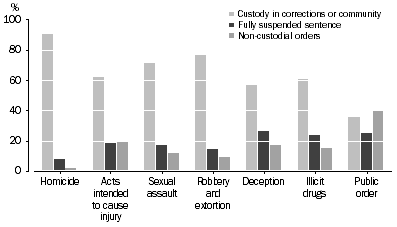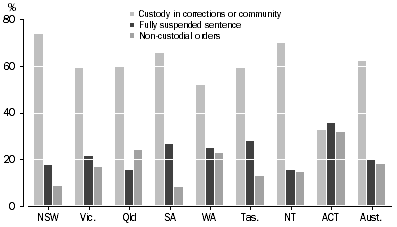SENTENCE OUTCOMES
In 2006-07, the majority (92% or 12,835) of defendants heard in the Higher Courts were proven guilty. Almost all defendants charged with illicit drug offences and weapons and explosives offences were proven guilty (both 98%), whilst defendants charged with an offence of sexual assault and homicide had lower rates of conviction (78% and 81% respectively).
The following information relates to sentence outcomes for defendants heard in the Higher Courts. Defendants are referred to as 'convicted' where they were proven guilty of at least one of the final charges laid against them.
Sentence refers to the principal sentence a defendant received (refer to Explanatory Notes paragraph 42 for further information).
Principal sentence
The majority (82% or 10,470) of defendants proven guilty in 2006-07 received a custodial order. This proportion increased over the last 5 years, from 74% in 2002-03. Custodial orders comprised: custody in a correctional institution (58% of convicted defendants); custody in the community (4%); and fully suspended sentences (20%).
Defendants with a sentence of non-custodial orders (community supervision or work orders, monetary orders and other non-custodial orders) accounted for 18% of defendants proven guilty in the Higher Courts.
The proportion of convicted defendants that received a custodial sentence in a correctional institution or the community ranged from 34% for public order offences to 76% for robbery and extortion, and 90% for homicide. Defendants convicted of offences against justice procedures or deception were more likely to receive a fully suspended sentence (27% and 26% respectively) than defendants with other offences. Of those defendants charged with public order offences, 39% were issued non-custodial orders.
DEFENDANTS PROVEN GUILTY, Selected principal offence by selected principal sentence

Sex
A greater proportion of males proven guilty received a sentence of custody in a correctional institution or the community than females (64% compared with 49%). Convicted females had a larger proportion of fully suspended sentences than males (24% and 19% respectively).
Age
A larger proportion of convicted defendants under 25 years of age received a non-custodial order (25%), compared with other age groups (ranging from 13% to 16%). Those under 25 years of age had the smallest proportion of all age groups sentenced to custody in a correctional institution or the community (56%).
Differences in sentencing across age and sex are associated with the offence the defendant was convicted of, as well as a range of aggravating and mitigating factors taken into account by the court, such as prior convictions, level of violence, whether the offender was provoked, and demonstrations of remorse.
States and territories
The proportion of defendants proven guilty that received a custodial sentence in a correctional institution or the community varied across states and territories, ranging from 33% in the Australian Capital Territory to 74% in New South Wales.
DEFENDANTS PROVEN GUILTY, Selected principal sentence by states and territories

 Print Page
Print Page
 Print All
Print All